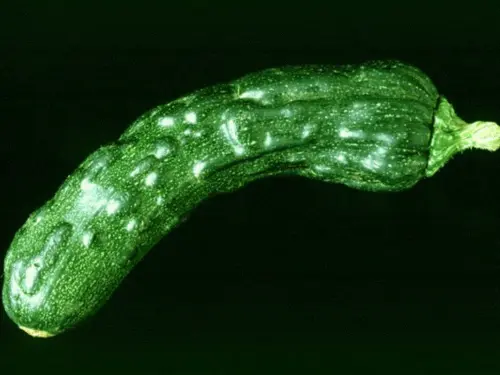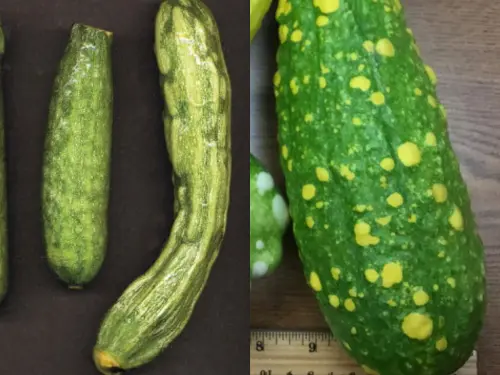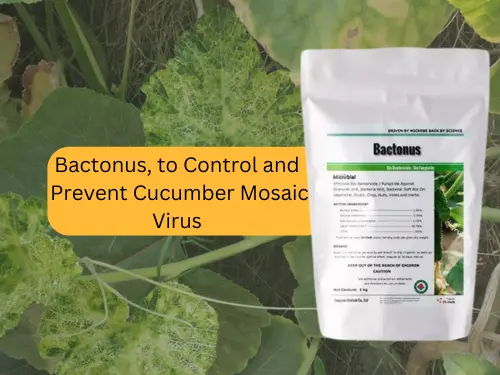How to Control and Prevent Cucumber Mosaic Virus?
Cucumber mosaic virus poses a significant threat to productivity. If your cucumber plants are losing their vigor, you might be wondering what you could do to correct the issue and why they’re turning brown.
You can control cucumber mosaic virus by using virus-free seeds/transplants and removing infected plants. Prevent its spread through proper sanitation, controlling insect vectors like aphids, growing resistant cultivars, and using cucumber fungicide.

Continue reading the blog to discover the treatment for cucumber mosaic virus, including the best fungicide for cucumber plants.
Reasons for Cucumber Mosaic Virus?
Mosaic viruses are a group of viral pathogens that affect a wide range of plants, including vegetables, fruits, and ornamentals. These viruses are aptly named for the distinct mottled or mosaic patterns they create on infected leaves. Cucumber mosaic virus symptoms can also include stunted growth, leaf distortion, and reduced yields. Insect vectors like aphids primarily transmit mosaic viruses through infected plant material.
Here are some reasons for the disease in bullet points with explanations:
- Insect Vectors: This is primarily transmitted by aphids, which act as vectors. These tiny insects can acquire the virus from infected plants and spread it to healthy ones as they feed.
- Infected Seeds/Transplants: Using seeds or transplants that are already infected with the virus can introduce the cucumber mosaic disease into a new growing area. The virus can be seed-borne, meaning it can be transmitted through infected seeds.
- Mechanical Transmission: The virus can also spread through mechanical means, such as contaminated tools, equipment, or even workers’ hands. Improper handling and lack of sanitization can facilitate the transfer of the virus from infected to healthy plants.
- Monoculture Cropping: Growing the same crop repeatedly in the same area can increase the risk of viral cucumber mosaic, as the pathogen can build up in the soil and plant debris over time.

What is Cucumber Mosaic Virus Treatment?
Here are some ways to control the disease in bullet points with explanations:
- Use Resistant Varieties: Develop cucumber varieties that are resistant or tolerant to cucumber mosaic virus by breeding them with genetic resistance mechanisms that can prevent or limit viral infection.
- Practice Crop Rotation: Rotate cucumbers with non-host crops to reduce the buildup of the virus in the soil and prevent reinfection. Avoid planting cucumbers in the same area for several consecutive seasons.
- Remove Infected Plants: Promptly remove and destroy any plants exhibiting signs of cucumber mosaic virus infection. This helps prevent the virus from spreading further to healthy plants.
- Use Certified Seed/Transplants: Obtain seeds or transplants from reputable sources that are certified to be virus-free. This helps prevent the introduction of the virus into your growing area.
- Apply Mulches: Use mulches around plants to create a physical barrier that can deter aphids and other insect vectors, reducing the risk of viral transmission.
- Use an Organic Funigicide: Bactonus is a best fungicide for cucumbers plants which is derived from the naturally occurring bacterium Bacillus amyloliquefaciens. This product works by colonizing plant roots and stimulating the plant’s innate defense mechanisms, enhancing its resistance to various fungal and bacterial cucumber mosaic diseases. Bactonus has proven effective against a wide range of pathogens, including those causing powdery mildew, botrytis, and bacterial wilt.

Bacillus velezensis, another product offered by Novobac, is a plant growth-promoting rhizobacterium (PGPR) that has demonstrated remarkable efficacy in controlling plant diseases and promoting overall plant health. This best fungicide for cucumber plants colonizes the rhizosphere (the area surrounding plant roots), and thereby produces a variety of compounds that inhibit the growth of pathogens while simultaneously stimulating plant growth and development.
Conclusion
Understanding, preventing, and treating cucumber mosaic virus is essential for the health of crops and the environment. Mosaic viruses and bacterial infections pose significant threats to plant productivity and yield, necessitating proactive measures to combat these pathogens. By embracing innovative products like Bactonus and Bacillus velezensis, growers can effectively manage plant diseases while promoting sustainable farming practices that prioritize environmental stewardship and long-term soil health.
Other Cucumber Diseases and Solutions
Root-knot nematode on cucumber– Nema Pro
Cucumber beetle control– Myco Pestop
Cucumber powdery mildew– Trianum V
References:
- Abdelkhalek, Ahmed, Said I. Behiry, and Abdulaziz A. Al-Askar. “Bacillus velezensis PEA1 inhibits Fusarium oxysporum growth and induces systemic resistance to cucumber mosaic virus.” Agronomy 10.9 (2020): 1312.
- Lee, Ga Hyung, and Choong-Min Ryu. “Spraying of leaf-colonizing Bacillus amyloliquefaciens protects pepper from Cucumber mosaic virus.” Plant Disease 100.10 (2016): 2099-2105.




Leave a Reply